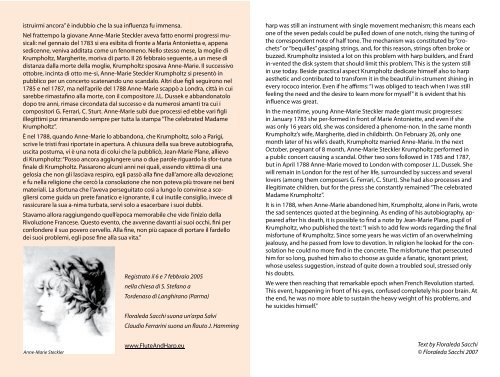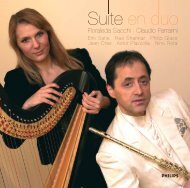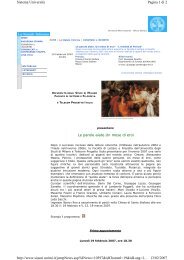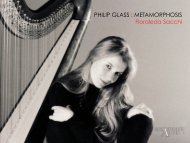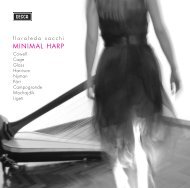download the booklet - Floraleda Sacchi
download the booklet - Floraleda Sacchi
download the booklet - Floraleda Sacchi
You also want an ePaper? Increase the reach of your titles
YUMPU automatically turns print PDFs into web optimized ePapers that Google loves.
istruirmi ancora” è indubbio che la sua influenza fu immensa.<br />
Nel frattempo la giovane Anne-Marie Steckler aveva fatto enormi progressi musicali:<br />
nel gennaio del 1783 si era esibita di fronte a Maria Antonietta e, appena<br />
sedicenne, veniva additata come un fenomeno. Nello stesso mese, la moglie di<br />
Krumpholtz, Margherite, moriva di parto. Il 26 febbraio seguente, a un mese di<br />
distanza dalla morte della moglie, Krumpholtz sposava Anne-Marie. Il successivo<br />
ottobre, incinta di otto me-si, Anne-Marie Steckler Krumpholtz si presentò in<br />
pubblico per un concerto scatenando uno scandalo. Altri due figli seguirono nel<br />
1785 e nel 1787, ma nell’aprile del 1788 Anne-Marie scappò a Londra, città in cui<br />
sarebbe rimastafino alla morte, con il compositore J.L. Dussek e abbandonatolo<br />
dopo tre anni, rimase circondata dal successo e da numerosi amanti tra cui i<br />
compositori G. Ferrari, C. Sturt. Anne-Marie subì due processi ed ebbe vari figli<br />
illegittimi pur rimanendo sempre per tutta la stampa “The celebrated Madame<br />
Krumpholtz”.<br />
È nel 1788, quando Anne-Marie lo abbandona, che Krumpholtz, solo a Parigi,<br />
scrive le tristi frasi riportate in apertura. A chiusura della sua breve autobiografia,<br />
uscita postuma, vi è una nota di colui che la pubblicò, Jean-Marie Plane, allievo<br />
di Krumpholtz: “Posso ancora aggiungere una o due parole riguardo la sfor-tuna<br />
finale di Krumpholtz. Passarono alcuni anni nei quali, essendo vittima di una<br />
gelosia che non gli lasciava respiro, egli passò alla fine dall’amore alla devozione;<br />
e fu nella religione che cercò la consolazione che non poteva più trovare nei beni<br />
materiali. La sfortuna che l’aveva perseguitato così a lungo lo convinse a scegliersi<br />
come guida un prete fanatico e ignorante, il cui inutile consiglio, invece di<br />
rassicurare la sua a-nima turbata, servì solo a esacerbare i suoi dubbi.<br />
Stavamo allora raggiungendo quell’epoca memorabile che vide l’inizio della<br />
Rivoluzione Francese. Questo evento, che avvenne davanti ai suoi occhi, finì per<br />
confondere il suo povero cervello. Alla fine, non più capace di portare il fardello<br />
dei suoi problemi, egli pose fine alla sua vita.”<br />
Registrato il 6 e 7 febbraio 2005<br />
nella chiesa di S. Stefano a<br />
Tordenaso di Langhirano (Parma)<br />
<strong>Floraleda</strong> <strong>Sacchi</strong> suona un’arpa Salvi<br />
Claudio Ferrarini suona un flauto J. Hamming<br />
harp was still an instrument with single movement mechanism; this means each<br />
one of <strong>the</strong> seven pedals could be pulled down of one notch, rising <strong>the</strong> tuning of<br />
<strong>the</strong> correspondent note of half tone. The mechanism was constituted by “crochets”<br />
or “bequilles” gasping strings, and, for this reason, strings often broke or<br />
buzzed. Krumpholtz insisted a lot on this problem with harp builders, and Érard<br />
in-vented <strong>the</strong> disk system that should limit this problem. This is <strong>the</strong> system still<br />
in use today. Beside practical aspect Krumpholtz dedicate himself also to harp<br />
aes<strong>the</strong>tic and contributed to transform it in <strong>the</strong> beautiful in-strument shining in<br />
every rococo interior. Even if he affirms: “I was obliged to teach when I was still<br />
feeling <strong>the</strong> need and <strong>the</strong> desire to learn more for myself” it is evident that his<br />
influence was great.<br />
In <strong>the</strong> meantime, young Anne-Marie Steckler made giant music progresses:<br />
in January 1783 she per-formed in front of Marie Antoniette, and even if she<br />
was only 16 years old, she was considered a phenome-non. In <strong>the</strong> same month<br />
Krumpholtz’s wife, Margherite, died in childbirth. On February 26, only one<br />
month later of his wife’s death, Krumpholtz married Anne-Marie. In <strong>the</strong> next<br />
October, pregnant of 8 month, Anne-Marie Steckler Krumpholtz performed in<br />
a public concert causing a scandal. O<strong>the</strong>r two sons followed in 1785 and 1787,<br />
but in April 1788 Anne-Marie moved to London with composer J.L. Dussek. She<br />
will remain in London for <strong>the</strong> rest of her life, surrounded by success and several<br />
lovers (among <strong>the</strong>m composers G. Ferrari, C. Sturt). She had also processes and<br />
illegitimate children, but for <strong>the</strong> press she constantly remained “The celebrated<br />
Madame Krumpholtz”.<br />
It is in 1788, when Anne-Marie abandoned him, Krumpholtz, alone in Paris, wrote<br />
<strong>the</strong> sad sentences quoted at <strong>the</strong> beginning. As ending of his autobiography, appeared<br />
after his death, it is possible to find a note by Jean-Marie Plane, pupil of<br />
Krumpholtz, who published <strong>the</strong> text: “I wish to add few words regarding <strong>the</strong> final<br />
misfortune of Krumpholtz. Since some years he was victim of an overwhelming<br />
jealousy, and he passed from love to devotion. In religion he looked for <strong>the</strong> consolation<br />
he could no more find in <strong>the</strong> concrete. The misfortune that persecuted<br />
him for so long, pushed him also to choose as guide a fanatic, ignorant priest,<br />
whose useless suggestion, instead of quite down a troubled soul, stressed only<br />
his doubts.<br />
We were <strong>the</strong>n reaching that remarkable epoch when French Revolution started.<br />
This event, happening in front of his eyes, confused completely his poor brain. At<br />
<strong>the</strong> end, he was no more able to sustain <strong>the</strong> heavy weight of his problems, and<br />
he suicides himself.”<br />
Anne-Marie Steckler<br />
www.FluteAndHarp.eu<br />
Text by <strong>Floraleda</strong> <strong>Sacchi</strong><br />
© <strong>Floraleda</strong> <strong>Sacchi</strong> 2007


